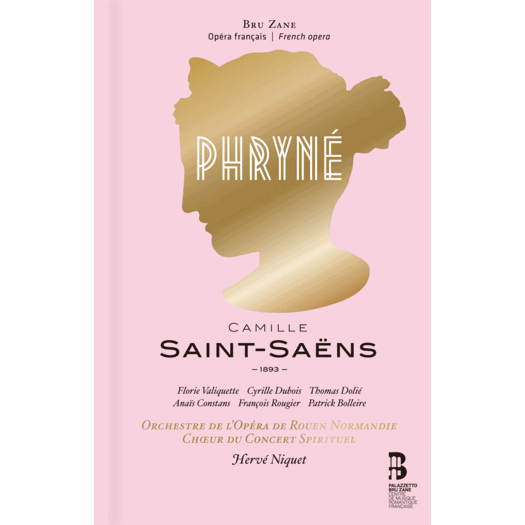- Elgar: The Dream of Gerontius
- Gerald Moore
- Rodelinda
- BBC Proms
- Mark Berry
- Navona Records LLC
- Soviet music
- Susanna Mälkki
 DISCUSSION: John Dante Prevedini leads a discussion about Improvisation in the classical world and beyond, including contributions from David Arditti, James Lewitzke, James Ross and Steve Vasta.
DISCUSSION: John Dante Prevedini leads a discussion about Improvisation in the classical world and beyond, including contributions from David Arditti, James Lewitzke, James Ross and Steve Vasta.
 SPONSORED: CD Spotlight. Perfect Indeed - More Beethoven from James Brawn, recommended by Andrew Schartmann.
SPONSORED: CD Spotlight. Perfect Indeed - More Beethoven from James Brawn, recommended by Andrew Schartmann.
All sponsored features >>

A Spicy, Sexy Comedy
GIUSEPPE PENNISI listens to Saint-Saëns' 'Phryné'
'... a very happy discovery where Greek myth marries French opéra comique.'
During Carnival celebrations, Palazzetto Bru Zane - Centre de musique romantique française presents a series of concerts and events directed at all kinds of audience. Following its mission — the rediscovery and international promotion of the French musical heritage of the long nineteenth century (1780-1920) — the Palazzetto is hosting the events in its headquarters: a 1695 Venetian palace that has been restored specifically for this purpose. The main event is the production of the operetta in one act Le 66! by Jacques Offenbach; it was staged by Victoria Duhamel on 25 and 26 February at 7.30pm and on 27 February 2022 at 5pm. This operetta had its debut at the Théâtre des Bouffes-Parisiens on 31 July 1856.
It requires a small ensemble: a clarinet (Rozenn Le Trionnaire) a blunderbuss (Lucas Perruchon) and a piano (Christophe Manien) in the pit; three singers (Paul-Alexandre Dubois, Flannan Obé), a simple set Guillemine Burin des Roziers) and nice costumes (Emily Cauwet-Lafont). It has all the features to be a very enjoyable carnival show.
A few weeks before Carnival, the Palazzetto Bru Zane—Centre de Musique Romantique published a rarity: a 164-page book (with essays and libretto in both French and English) of Phryné by Camille Saint-Saëns, an opéra comique that had its debut in Paris in 1893 and was very successful at the time. It was seen and heard in all the important theatres of the French speaking area; in 1896 Phryné was revised: the spoken parts were replaced with recitatives (by André Messager) in order to be performed abroad, mostly in the German speaking areas where comic operas with spoken parts were hardly accepted,
The CD and book are part of a program to celebrate the hundredth centenary of Camille Saint-Saëns' death by rediscovering operas now forgotten. As a part of this program, operas such as Proserpine, La Princesse Jaune and Le Timbre d'Argent have been staged and/or recorded as well as reviewed in this magazine.
According to the myth, Phryné is Greek courtesan, who lived in the fourth century BC. She was a native of Thespie in Boeotia and her real name was Mnesarete: it seems that the nickname was given to her for her pale complexion. Probably she came to Athens shortly before 370 BC, after the destruction of Thespians by the Thebans: she must have been very young then. Around 365 BC her relationship with Praxiteles arises; the artist portrayed her in two statues, one of which was in the sanctuary of Apollo at Delphi, the other at Thespians next to Aphrodite and Eros also by Praxiteles; Phryné herself had donated this last statue to her home town, after having cleverly obtained it from the artist. This has all the appearance of a legend, including the news that she would have served as a model for the Aphrodite Cnidia, and also that for which she would also have inspired the Aphrodite Anadiomene of Apelles. The most famous fact of her life is the process in which she was defended by Hyperid: around 347 BC. She was accused of having formed an illicit association of men and women for the worship of a new deity, Isodaite. The cause of impiety that took place before the Eliasts ended with a well-known episode: Hyperid, seeing that words were not sufficient to move the souls of the judges, uncovered his client's body, thus obtaining her absolution.
This is in the background of the opéra comique. The plot revolves around an old magistrate who wants to prevent a relationship of his young nephew with the courtesan. He pretends to be a supporter of strict morality, especially in the sexual sphere. However, he himself is very attracted to Phryné. The two youngsters outwit him and arrange that the old man is found in the courtesan's bed in an embarrassing position (before any sex is consummated) by the full members of the household. To appease everybody, the magistrate gives his nephew half of his fortune and lets the young man and Phryné be happy in their relationship.
The plot is set in ancient Greece but it is in fact in Paris. It is a spicy, sexy comedy like a Sacha Guitry pochade - perfect for a Parisian Carnival evening.
The musical part is entrusted to l'Opéra de Rouen Normandie with the orchestra conducted by Hervé Niquet, the chorus Concert Spirituel and a group of young singers with Florie Valiquette (Phryné), Cyrille Dubois (her young lover), Thomas Dolié (the uncle) as well as Anaïs Constans, François Rouger and Patrick Bolleire in supporting roles.
Listen — Saint-Saëns: Introduction (Phryné Act I)
(BZ 1047 track 1, 0:00-0:24) ℗ 2022 Palazzetto Bru Zane :
The 'happy go lucky' atmosphere is clearly set from the introduction and in the gorgeous ending of the first act - a grand concertato when all singers and the chorus are on stage.
Listen — Saint-Saëns: Phryné, je vous rends grâce (Phryné Act I)
(BZ 1047 track 8, 8:33-9:31) ℗ 2022 Palazzetto Bru Zane :
In the second act, the uncle's couplets, the discovery of the old magistrate with the courtesan and the final ensemble are quite witty (musically too).
Listen — Saint-Saëns: Voyons! mon petit inventaire (Phryné Act II)
(BZ 1047 track 14, 0:00-0:39) ℗ 2022 Palazzetto Bru Zane :
Listen — Saint-Saëns: Salut et gloire (Phryné Act II)
(BZ 1047 track 17, 0:54-1:17) ℗ 2022 Palazzetto Bru Zane :
In short, this is a very happy discovery where Greek myth marries French opéra comique.
Copyright © 28 March 2022
Giuseppe Pennisi,
Rome, Italy

CD INFORMATION - SAINT-SAËNS: PHRYNÉ
CLASSICAL MUSIC ARTICLES ABOUT FRANCE


